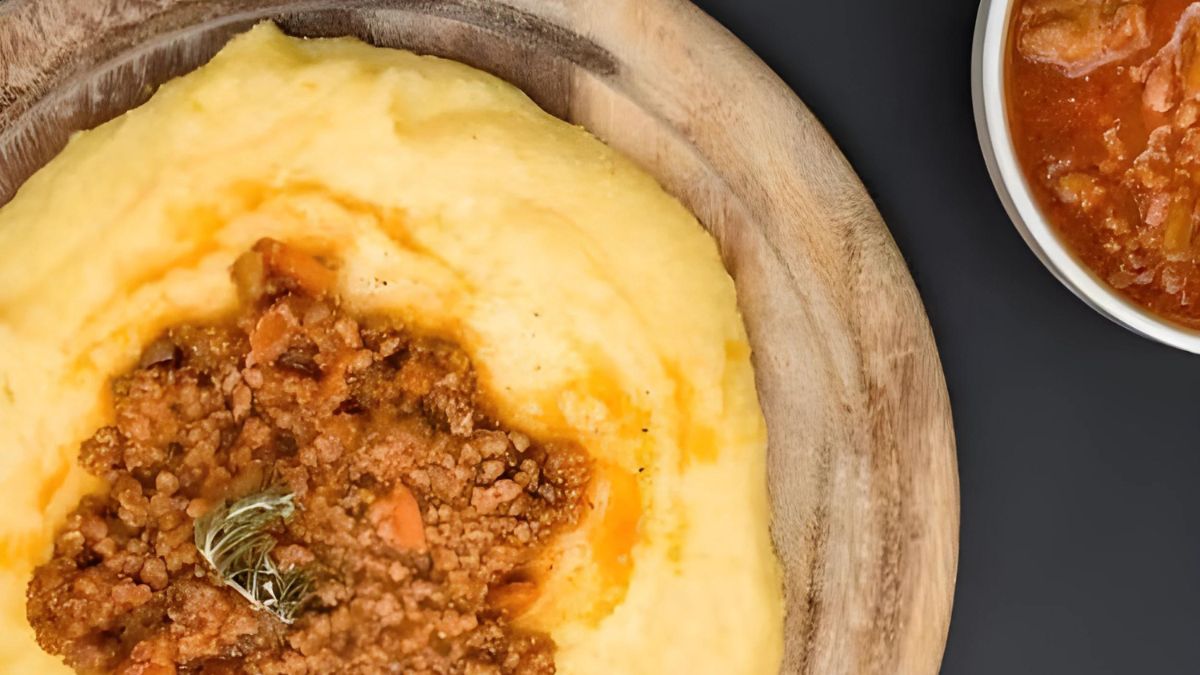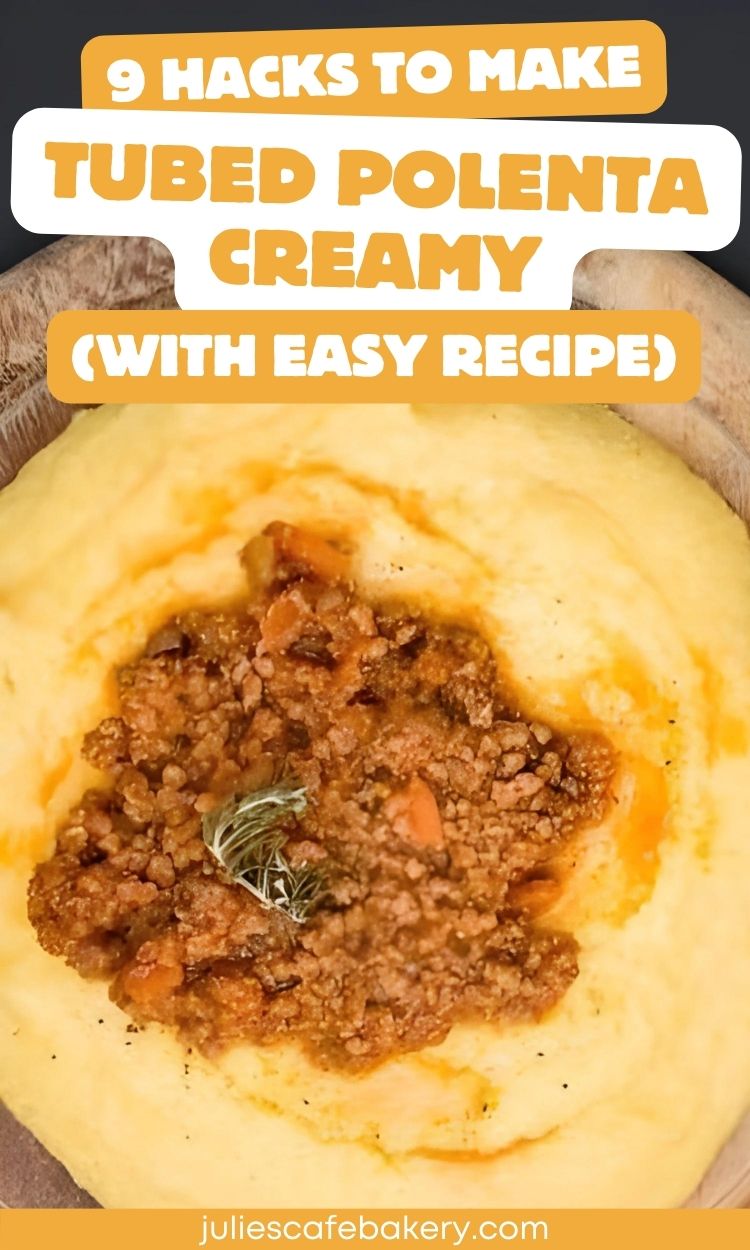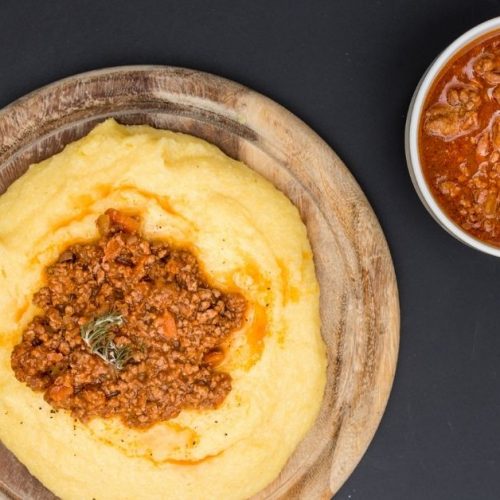9 Hacks To Make Tubed Polenta Creamy (With Recipe)

Tube polenta is fully cooked polenta, only in a tube. The reason tubed polenta is so popular is that it is even easier to use than boxed polenta- it is literally the “just add water” kind of thing. However, it’s not only water you could add, as there are a few other things you could mix your tube polenta with. So, how to make tube polenta creamy?
Adding water, milk, or butter can significantly soften tube polenta and make it creamy. Another way is to add cream cheese, heavy cream, sour cream, or crème Fraiche. Olive oil could also work, but it needs an additional ingredient from the abovementioned so as not to make the polenta lumpy.
Polenta is an incredibly tasty way for a speedy meal, and it is a shame that it is so underrated, mainly because lack of information on how to add some style to it. Therefore, in the following paragraphs, I will give some ideas on how to make tubed polenta creamy and what to combine it with.

Making tubed polenta creamy
Adding one or a few ingredients can make wonders, and these tips prove that. So, choose what you find the most convenient method for you, and make your tube polenta creamy.
Add water
Water is always a good idea to make something creamy, but in the case of tubed polenta, it could indeed do wonders. Tubed polenta is a precooked polenta that you just need to slice and heat. Therefore, adding some extra water to your tubed polenta will add to the already present moisture without making it lumpy.
If you want to make it more flavorful, choose chicken broth over water.
Opt for milk
Milk is another excellent option to add creaminess to your tubed polenta. When added to grainy consistencies, milk tends to turn them into pudding-like textures, which is why it would do wonders here too. A word to the wise, though, when adding milk to polenta, add it lukewarm rather than cold or hot so as to avoid lumps.
Do not substitute dairy milk for plant-based milk, as it won’t do a good job here. If you want a vegan polenta, add creaminess using water instead of switching to vegan milk.
Add some butter
Butter in itself could make your polenta creamy, but you’ll need a significant amount. So to avoid getting a fatty polenta, you might want to mix the butter with milk or water and then add it to the polenta. However, if your polenta is on edge and needs just a bit, feel free to work with butter alone.
You can melt the butter before adding it to the polenta, or you can let it melt inside; however, in any case, please continuously stir until the butter is evenly distributed.
Or add cream cheese
Cream cheese and polenta go perfectly. Not only do they mash heavenly taste-wise, but their textures are incredibly compatible. Adding cream cheese to your polenta will not only make it creamy but rich and elegant as well.
Before adding the cream cheese to the polenta, try and whisk it to make it a bit less thick.
Add heavy cream
Another excellent and easy-to-implement idea. Given that heavy cream is indeed heavy, you won’t need to go overboard and fatten up your polenta to make it creamy. Mixing it with some heavy cream while you are still cooking it will make your polenta smooth and silky.
Opt for sour cream
Sour cream is an excellent solution after your polenta has been cooked. Sour cream will give it creaminess and freshness too. However, since sour cream is used cold, be prepared for a few lumps.
Not to worry, though; you will easily break the lumps as the sour cream softens at room temperature in your polenta plate.
Add crème fraiche
Just like with the sour cream, crème fraiche is also best cold, so expect a few lumps here too. However, the incredibly refreshing, soft, and tender crème fraiche will make your tubed polenta creamy beyond imagination.
Include olive oil
Olive oil made its way to this list because it would be a great companion to whatever method you choose from the abovementioned. I don’t recommend using olive oil alone, as it will make your tubed polenta lumpy, so it is best that you combine it with an ingredient you choose.
Heat it up and add grated cheese
Grated cheese like Gouda won’t work alone, you will need to add water or milk first. Liquid will help you to heat up the tube polenta, and after that, add a cup of grated cheese. Wait for it to melt and you have yourself a nice and creamy tube polenta.
TIP: Although all the suggested ideas, except for the olive oil, would do a good job when used alone, I’d recommend pairing them for better results. So mix the heavy cream with some milk, or the sour cream with some oil, or the crème fraiche with some butter.
Jump to RecipeIs tubed polenta better with milk or water?
Whether you make tubed polenta with milk or water is more of a personal preference than a matter of which is better. However, making your polenta with milk will result in creamier and smoother polenta with a fuller taste. If you make it with water, it will be lighter, maybe not as creamy, but nevertheless tasty.
What is the best way to reheat polenta?
Generally speaking, you don’t reheat polenta. Since it is essentially cornmeal, polenta doesn’t do well when reheated; however, it is doable.
The first thing to remember when reheating polenta is not to force it, so medium heat is more than enough. Another thing to keep in mind is to always add a liquid when reheating it.
Cornmeal is very absorbent, so no matter how much milk or water you use while making the polenta, it will get absorbed until the time comes to reheat it. Therefore always add at least half a cup of water or milk.
Stir all the time while reheating. The polenta will likely be lumpy, so stirring it while reheating will return its creaminess.
Avoid reheating it in the microwave or an appliance other than the stove. Polenta is best reheated the same way it was initially made.
What goes with creamy polenta?
Creamy polenta goes with a number of sides. Cheese is one of the best polenta pairs. Whether you grate it over your plate or have your cheese on the side doesn’t make any difference, as it will do wonders either way.
Another great side to polenta is a fresh green salad with lettuce, arugula, and diced tomatoes. Sprinkle some basil on your polenta, and voila! You have yourself a fancy meal.
Polenta also goes with deli meats, such as salami or prosciutto. Another delicious idea is to pair, or polenta with are grilled smoked sausages.
Nuts, almonds, pistachios, hazelnuts, peanuts, and any other type of nuts will mash excellent with our polenta. The creaminess of the polenta could actually use the playful nutty texture.
Zucchini ribbons are a creative, refreshing, and decorative way to make your polenta interesting. Roasted potatoes with parmesan, or even better, roasted vegetables, will spice up your polenta.
Polenta goes excellent with sauces. Some of my suggestions are bolognese sauce and salsa.
Roasted or grilled mushrooms with garlic are another great idea to up the flavor of your creamy polenta.
It may sound a bit unusual, but creamy polenta also goes great with dried fruit such as raisins or dried figs.
How long does creamy polenta last?
If made with water, polenta is slightly more durable than milky polenta. Still, it isn’t a long-lasting dish.
On the counter, your creamy polenta could last for a couple of hours, after which you’ll have to store it. In the fridge, it could stay good for about 4-5 days, and in the freezer, it would keep for up to a month.
If you want to make something with polenta leftovers, there are always ways.
How to store creamy polenta?
The best way to store creamy polenta would be to place it in airtight containers. However, if this is not possible, feel free to store your polenta in the pot where you made it, but make sure you prevent air from penetrating it.
Cover the pot with plastic foil and seal the edges. This will produce an effect very similar to that of the airtight container. If you store your polenta on a plate, make sure it is a porcelain plate to make it easier to slide it off.
Again, please make sure no air gets to your polenta by covering it with a lid, aluminum foil, or another plate. I can’t stress enough how important it is to prevent air from penetrating the polenta. It won’t only get hard, but it will become dry, making it impossible to reheat.
If you decide to freeze your polenta, feel free to use freezer baggies and then place them in a plastic container if you don’t have an airtight container handy.
How to use tubed polenta?
Known to be a suitable substitute for rice and mashed potatoes, tubed polenta can go wherever rice and mashed potatoes would. Therefore, feel free to use it as an addition to your roasted chicken, glazed chicken breast, or even meatballs.
You can also use tubed polenta to make grilled creamy polenta, polenta fries, or polenta lasagna. Even polenta pancakes are an option with tubed polenta; just make sure you crisp up the polenta slices, pour some syrup on them, and enjoy.
Broiled polenta canapes are also a great way to use tubed polenta. Sizzle them up nicely and top them with your favorite Lunchables.
Polenta casserole is another thing you could try. Just layer the polenta slices with cheese and salsa sauce, bake, and feast.
Recipe for creamy tube polenta

Make Tube Polenta Creamy!
Ingredients
- 1 tube Polenta
- 3/4 cup Whole Milk
- 1/2 cup Grated Cheese I recommend Gouda since it melts easily.
- A little bit of salt.
- Pepper to taste.
Instructions
- Mash well the tube polenta in one pot.
- Add milk and spices and mix. Put the pot over medium heat and cook the mixture.
- When the polenta is hot, turn off the heat and add grated cheese. Stir well until it melts completely.
- Serve creamy tube polenta with your favorite dish. I suggest bolognese sauce or baked chicken drumstick.
